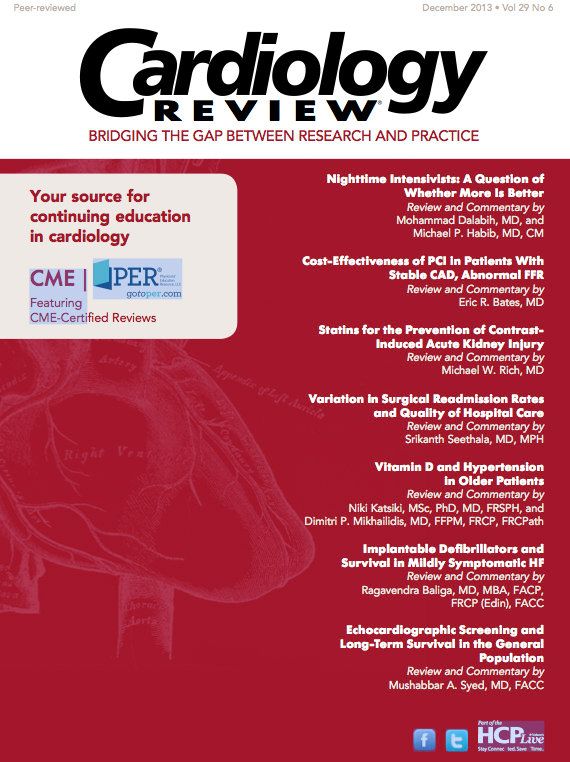Enjoy the Holidays and New Year With Cardiology Review
Editor-in-Chief Debabrata Mukherjee, MD, MS, FACC, welcomes our readers to a new year of Cardiology Review.
Debabrata Mukherjee, MD, MS, FACC
Editor-in-Chief
I hope everyone has had an enjoyable holiday season, and I want to wish everyone a wonderful New Year. With the holidays over, it is back to work for most of us, and Cardiology Review will help us get caught up with the latest news and advances in cardiology. This particular issue of CR discusses many important articles and viewpoints that I am sure you will find quite useful.
Dr. Eric Bates delves into the cost-effectiveness of percutaneous coronary intervention (PCI) in patients with stable coronary artery disease and abnormal fractional flow reserve (FFR), and opines that revascularization for ischemia is reasonable, but current data do not prove superiority of FFR-guided versus angiography-guided decision making. FFR appears to be most useful when the indications for PCI are ambiguous based on noninvasive testing and coronary angiography or when noninvasive testing is absent, equivocal, or does not provide objective evidence of ischemia in the myocardial territory perfused by the index artery.
Dr. Ragavendra Baliga discusses the role of implantable defibrillators (ICD) and survival in mildly symptomatic heart failure (HF), and states that given that sudden death is more likely to occur in milder forms of HF, ICDs are more likely to be the treatment of choice in these patients, whereas a biventricular pacemaker is more likely to be the device of choice in advanced forms of HF. Drs. Mohammad Dalabih and Michael Habib look at the value of nighttime intensivists and reflect that until there is evidence to the contrary, our priority should be to make sure that every critically ill patient is cared for in an ICU staffed by a daytime intensivist, and not to spend more money staffing a select few ICUs around the clock.
Drs. Niki Katsiki and Dimitri Mikhailidis discuss vitamin D and hypertension in older patients and report that that high-dose cholecalciferol supplementation every 3 months for a year was ineffective in reducing blood pressure in older (≥70 years) patients with isolated hypertension. They think that further randomized clinical trials are needed to clarify the role of vitamin D supplementation in daily practice. Dr. Michael Rich reviews the role of statins for the prevention of contrast-induced acute kidney injury (CI-AKI) and points out that that there is a growing body of literature that supports the use of statins for prevention of CI-AKI, at least in selected high-risk populations, and it seems very reasonable to prescribe statin therapy prior to coronary angiography or PCI in patients at moderate to high risk for CI-AKI.
Dr. Srikanth Seethala examines variation in surgical readmission rates and quality of hospital care, and reflects that performing elective procedures only at highly experienced centers might provide a better outcome, but the practicality of this approach should be carefully investigated, as low-volume centers might need to perform emergency procedures. Dr. Mushabbar A. Syed discusses echocardiographic screening and long-term survival in the general population and emphasizes that although there is general agreement that these tests can detect early cardiovascular disease, there is lack of agreement on which test is best, when/who to screen, and the overall appropriateness of this approach.
For our Clinical Forum section, Drs. Mehdi Shishehbor, Hitinder Gurm, and Timir Paul review the optimal duration of dual antiplatelet therapy (DAPT) after implantation of drug-eluting stents, and in general suggest an individualized approach by careful assessment of a balance between stent thrombosis and risk of bleeding, but overall favor 12 months of DAPT for most patients.
Finally, the insightful compilation of top stories and meeting highlights from the American Heart Association 2013 Scientific Sessions by our excellent managing editor, Ms. Jackie Syrop, should keep you updated on the latest happenings presented at the meeting. She discusses results of the CATIS trial, ENGAGE AF-TIMI 48, TOPCAT, CORAL, NIAMI, and the CTSN trial.
I hope that you will find these commentaries to be valuable and enjoyable. I encourage you to share your insights, thoughts, and personal experiences on the topics touched upon in this issue. On a broader level, I would love to hear feedback on how we can make this journal even better. My goal continues to be to make you look forward to every issue of Cardiology Review—online and on iPad.
Debabrata Mukherjee
Editor-in-Chief
